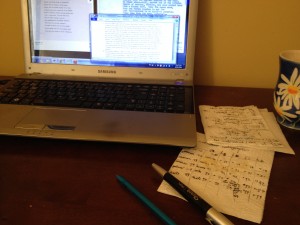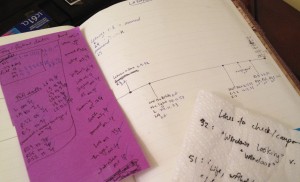Community
March 7, 2014
Draft 1, Draft ?, Draft ?: Editorial Notes and Nuisances
So, as some of you may know, for the past year and a half I have been working with Michael DiSanto on the George Whalley digital edition, the basis of which is a huge Whalley database. The first year was a serious learning journey filled with reading, training (DHSI!), planning, scanning, scanning, and more scanning, editing, uploading, describing, and transcribing. Now, the Whalley database has been migrated to a spiffy new website designed by Robin Isard, and we are really moving toward our digital edition. What I’ve been doing for the last several months is writing editorial notes for the poems we have selected as definite inclusions for the edition: “Elegy,” “Battle Pattern,” “Calligrapher,” “Pig,” “A Minor Poet is Visited by the Muse,” “Lazarus,” “Letter from Lagos,” and “Dionysiac.” Each note has ended up between 1500-3000 words, depending on how involved Whalley’s revision process was. Each one includes certain common elements: a description of the number of extant texts and their pages in manuscript and typescript, the publication history, a chronology of the versions, and any relevant biographical details (some of these are pretty fun, like the fact that “Pig” was inspired by a pig footstool Whalley bought in London).
Determining the chronology of documents has guided my writing of these notes, as I personally find the way the text has morphed from one version to the next over time to be the most important element of defining the revision process for a user. I begin by consulting the timeline of poems created for the project by “research assistant extraordinaire” Stacey Devlin, to make sure I don’t miss any documents corresponding to revision dates already identified, and then consulting the timeline of Whalley’s life to confirm where he was and what he was doing while writing the poem. Then I scour the database, checking in the relevant record container for all versions of the poem and using the search function to find related documents (pictures, audio recordings, etc). I jot down the titles of all the documents, with dates (if available), brief descriptions, and item numbers, and confirm that I’ve got all the dates recognized in the timeline covered (or make notes of which ones I’m missing!). Then the tough part starts—which version comes when? To start, I use the dated documents (there are always a couple of these, thanks to Whalley’s organizational foresight) to create a skeleton revision outline, then add tentative works to it based on their titles, placing together, for example, all the drafts titled “Resurrection Stone,” and all the ones titled “Lazarus.” When a document is untitled, we title it using the first line, so I can group these together too. Working with these smaller groupings, I then compare the works against one another line by line, making note of where handwritten revisions and marginal notes have been incorporated, where changes apparently not indicated by revision marks occur, and where one base text corresponds to another. I re-group, un-group, and group the versions again, and connect the groups to one another. This part of the process, where I compare different versions and note revisions, looks something like this:
As you can kind of see in the notes, the revisions I’ve recorded in the top draft are incorporated in a draft I’ve called “RS3” for short (“Resurrection Stone [3]”), and I’ve discerned that this draft is spread across multiple one-page records. I also use a whole slew of less technical aides, including the old post-it note page tracker, handwritten timelines, and the odd napkin collation (it’s the poor man’s Juxta!).
By the end, I’ve got a firm grasp of what I think the chronology is, and why, and can pinpoint particularly illuminating instances of revision for the reader of the editorial notes.
The images above are taken during my writing of the editorial note for “Lazarus,” which has been the most involved one yet (edit: not as involved as “Dionysiac,” which was printed in two separate versions and has only one real cross-over version!). I often feel very lucky to work on someone as organized as Whalley, who dates his drafts often and uses reasonably legible proofreading marks. One of the most confusing things about discerning the order in which various pieces and drafts of “Lazarus” were produced, though, is that Whalley seems to have flip-flopped a number of times on some things—on one draft he’ll change a certain word, phrase, or line break, and he’ll incorporate this change in the base text of another draft, and then in the next draft it’ll be back to the way it appeared before! One example of this is the way Whalley worked on the poem without, then with, then finally without its first stanza. A smaller and more tedious instance of this is his back-and-forth over what would become line 30 in the published poem, which appears as “He claws his way out of the undertow,” then “Out of this undertow he claws his way,” and back again, and back again, several times.
To be honest, I’m really enjoying writing these notes. I get unreasonably excited about discovering sources of Whalley’s inspiration, even if I can’t figure out how they’re being used—for example, there’s a marginal note on the very first draft of “Lazarus” that reads “See V. Woolf ‘On Not Knowing Greek.’” I took a fair stab at explaining this, but I’m still not totally sure what the connection is. A more obvious source of inspiration for “Lazarus” is the sculpture of that name by Jacob Epstein, the posture of which is the focus of Whalley’s early drafts of the poem.
This is probably quite an idiosyncratic “how-to” for editorial notes, but I hope it was illuminating in some way. I would welcome any tips and tricks from veteran editors on how to polish my approach!


